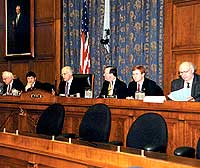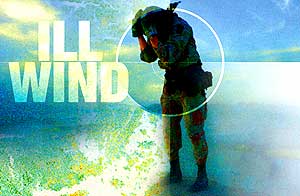
| ||
|
|
As another Middle East conflict dies down, veterans and doctors say the previous round’s biowarfare casualties remain mysteriously ignored
By Thomas G. Whittle & Linda Amato
 More than a dozen years after Desert Storm, Gulf War Illness’ biological factor still plagues veterans and their loved ones – a bitter harvest for our victorious forces and an ongoing tragedy for their loved ones.
More than a dozen years after Desert Storm, Gulf War Illness’ biological factor still plagues veterans and their loved ones – a bitter harvest for our victorious forces and an ongoing tragedy for their loved ones.
Janyce longed to be a mother, to raise children and see them prosper. In 1994, she married Arvid Brown, and was elated when she learned a child was on the way. When Asa was born the following year, Janyce raised him with a loving heart, swallowing her feelings about his problems.
With only one in 28 babies in America born with some type of physical defect, odds were that their next child would be healthy. But when daughter Helen entered the world in 1997, she was multiply disabled. Asa, then 3, remained unable to talk and had trouble using his hands.
Compounding the situation, Arvid also suffered from debilitating ailments. His symptoms had first appeared during the Persian Gulf War, while serving at the 301st Military Police Prisoner of War Camp near Hafir Al Batin in Saudi Arabia. The day he arrived there in 1991, chemical weapon alarms sounded as Scud missiles rained. By the end of his Gulf tour, Arvid’s ailments included rashes, diarrhea, headaches, nausea and vomiting. And as bad as that was, his condition deteriorated further after returning to Michigan.
“I experienced pains so incomprehensible that I would pass out,” he told Freedom. “I had photophobia [extreme sensitivity to light] and heat intolerance that prevented me from going outside. I experienced loss of orientation, blurred vision, tremors and other neurological signs and symptoms,” including loss of balance and memory.
Fever and bone pain extended to every part of his body. Night brought no relief as sweats, chills and other symptoms combined to make sleeping difficult, sometimes impossible.
Janyce, healthy prior to marrying Arvid, developed serious physical problems similar to her husband’s. “Chemicals are not contagious,” she said, drawing her own conclusion that biological toxins to which Arvid was exposed in the Persian Gulf must have been transmitted to her.
Her belief was borne out by, among other indications, medical tests that showed all four family members had leishmaniasis, a sometimes fatal disease normally spread by sand flies in the Persian Gulf and other desert regions — one of the contagious illnesses afflicting veterans who served in the Gulf War.
 Saddam Looks for “Novel Ways to Kill”
Saddam Looks for “Novel Ways to Kill”
|
Chemical weapons are, of course, chemicals. They include nerve gas, mustard gas, cyanide, tear gas and other substances. While toxic, they are not contagious.
“The thing that I can say with a high degree of confidence about Saddam Hussein and about his programs, his chemical-biological weapons programs especially,” Patrick Eddington, former CIA analyst and author of Gassed in the Gulf, told Freedom, “is that they were always looking for novel ways to kill people. And to kill them slowly, often-times, if at all possible, in order to increase their suffering.”
Eddington observed that Saddam’s style is to make people suffer. The chemical and biological toxins alleged to be in Saddam’s inventory since the days of the Iran-Iraq War (1980–1988) constitute the most lethal substances known to man, including mutated forms of virulent germs. In addition, Iraqi forces have combined chemical and biological weapons, as in 1988, when they mixed aflatoxin, a biological agent known to cause cancer, with riot gases and used them against the Kurds with deadly effect.2
The possibility of chemical warfare contamination of Gulf veterans was repeatedly denied by Pentagon spokespersons from the onset of soldier complaints in 1991. However, in the midst of an intensified investigation of the problem by Freedom in 1996, with evidence of chemical weapons contamination mounting to the point of being irrefutable, the Defense Department admitted exposure of American forces to Iraqi chemical agents.3
Since then, the numerous cases of illness passed from veterans to spouses, children and even household pets, according to experts interviewed by Freedom, continues to present the specter of Gulf War Illness’ biological factor — a bitter harvest for the victorious forces and an ongoing tragedy for their loved ones.
Apparent Cause —Neglected Cure
Garth Nicolson, Ph.D., and his wife, Nancy Nicolson, Ph.D., initially conducted research into Gulf War Illness at the M.D. Anderson Cancer Center at the University of Texas in Houston. There, the Nicolsons isolated an apparent cause of sick veterans’ symptoms in a possible component of a Saddam biological cocktail — the microorganism known as Mycoplasma fermentans incognitus (MFI), which can cause protracted illness and a lingering death.
The Nicolsons’ studies have shown that approximately 40 percent of veterans complaining of Gulf War Illness symptoms have mycoplasma in their bodies. And roughly 80 percent of those have the rare MFI — a strain harbored by only about 1 percent of the general population, according to Garth Nicolson. Ironically, MFI was patented by Shyh-Ching Lo, M.D., then a researcher at the Armed Forces Institute of Pathology, now chief of the institute’s Division of Molecular Pathobiology.
The Nicolsons served as consultants to physicians treating veterans, with many of their first clients from America’s premier fighting organizations, such as the Army’s Special Forces and Delta Force and the Navy’s SEALs. But soon they found themselves helping to treat veterans’ spouses and children.
In their ongoing research and efforts to assist veterans at the Institute for Molecular Medicine in Huntington Beach, California, the Nicolsons have been consulted in the treatment of thousands of Gulf veterans and their family members.
According to Garth Nicolson, the institute’s president, roughly 80 percent responded favorably to a regimen that included vitamins and antibiotics, particularly doxycycline.
Sick Gulf veterans learned, however, that some doctors serving the armed forces and the Department of Veteran Affairs (VA) refused to acknowledge the effectiveness of doxycycline. As one retired Special Forces officer pointed out, “I got my blood sent to Dr. [Garth] Nicolson for free testing and got my prescription for doxycycline. I went to have it filled and not only did they take away my military ID card, but they would not allow me to have the doxycycline to save my life.”4
Evidence of Physical Injury
In 1997, Arvid Brown lost his job, physically unable to meet his employer’s standards. And he could not find a doctor able to explain his condition—or his children’s. But as more and more Gulf veterans stepped forward with similar reports, Brown realized that he had contracted something communicable — a form of what has become known as Gulf War Illness — and passed it on unwittingly to his family.
While bureaucrats waffled about the mounting evidence of illness and doctors “studied” the matter, veterans’ problems only intensified.
In 1998, when Arvid and Janyce Brown went outside the VA system to a private clinic and all four family members tested positive for leishmaniasis, they knew they had found at least part of the answer.
Forms of leishmania — the group of parasitic microorganisms that cause the illness — were apparently suspected by UN inspectors to be in Saddam’s inventory.5 Yet, to this day, more than a dozen years after Desert Storm, Arvid and many other veterans have been unable to obtain adequate medical assistance for symptoms caused by biological means, including possible biological warfare agents, or by chemical agents and toxins, despite evidence of physical damage.
Studies documenting physical injury include those conducted by researchers at the University of Texas Southwestern Medical Center at Dallas. Headed by Robert Haley, M.D., this team showed conclusively that sick Gulf veterans sustained brain damage. Corresponding with the regions injured, “UT Southwestern researchers identified a syndrome characterized by thought, memory and sleep difficulties; a second syndrome that involves more severe thought problems as well as confusion and imbalance; and a third syndrome of sore joints and muscles and tingling or numbness in the hands and feet.”6
Researchers linked the damage to multiple chemical exposures: chemical warfare agents, anti-nerve gas tablets, pesticides and insect repellents. Continuing their research, they subsequently found that Gulf veterans complaining of dizziness also experienced brain damage.7
“A Bona Fide Crisis”
|
 Of the 696,778 U.S. troops in the 1990-1991 Operation Desert Shield (the build-up of Persian Gulf forces beginning in August 1990) and Desert Storm (the air war against Iraq from January to February 1991, culminating in the 100-hour ground assault), 148 were killed in action and 235 died from other causes, such as accidents.8
Of the 696,778 U.S. troops in the 1990-1991 Operation Desert Shield (the build-up of Persian Gulf forces beginning in August 1990) and Desert Storm (the air war against Iraq from January to February 1991, culminating in the 100-hour ground assault), 148 were killed in action and 235 died from other causes, such as accidents.8
In the years after, however, the price rose, with 206,861 — 29 percent of those who served — filing for VA disability compensation as of May 2002. CNN has since reported the figure climbing to 209,000, with 161,000 receiving disability payments.9 Meanwhile, veterans’ advocates have claimed that Gulf War deaths have steadily mounted.
Documents Freedom obtained from the VA showed that as of December 1997 — the most recent data provided — 4,506 Gulf veterans had died. However, the Gulf War Veterans Information System website, administered by the VA, revealed that as of May 2002 — the most current data — that number had risen to 8,013. The latter figure constitutes 1.15 percent of the 696,778 deployed to the Gulf — nearly double the 0.69 percent death rate among Gulf War-era servicepersons who were not sent there.
“This is a bona fide crisis,” said Garth Nicolson. We’re not moving fast enough to care for those already affected, he said, yet more Americans are now in the region where they, too, are in harm’s way.
More Deaths Predicted
As startling as the official tally may be, many think the actual toll is even higher. Nicolson believes tens of thousands of Gulf veterans have died, based on a confidential estimate of 28,000 deaths he said he received several years ago from a senior Defense Department official.
Joyce Riley, an Air Force captain and flight nurse during the Gulf War who has tracked veterans and their health problems ever since, told Freedom that a source within the VA informed her that 40,000 Gulf War veterans had died — a figure contested by the VA when asked by Freedom.
Riley also believes up to 400,000 Gulf veterans are now ill. And she stands by her figures. The 40,000 deaths estimate, she said, came from a national-level VA official. She predicts that unless successful treatments are embraced, the toll will continue to rise. “Given the fact that there are now 400,000 sick,” she said, “in 10 years’ time, I would say [there will be] 80,000 to 100,000 deaths.” (See “Desert Storm: Deadlier than Vietnam?”.)
In a January 2002 hearing before the U.S. House of Representatives’ Veterans’ Affairs Committee, Representative Bob Filner (D-CA) warned that it was “absolutely vital that we figure out what happened in the Persian Gulf War, [and] treat those who are suffering from illness.... [A]s we all well know, there is a high probability that our troops will be in the area again.”
In an investigation that stretches back to when reports of Gulf War Illness first surfaced, Freedom interviewed scores of informed sources who echoed his concern that something must be done.
“The Iraqi Curse”
In addition to the thousands of deaths and hundreds of thousands of disability applications from among U.S. veterans, men and women of other nations who served in the Gulf have also experienced severe health problems.
In Great Britain, for example, Gulf veterans suffer from lymphatic cancer at nearly twice the normal rate of men of similar age.10 In Denmark, 40 percent of the troops that served in the Gulf War are said to have Gulf War Illness.11
And in southern Iraq, the focus of Desert Storm operations, both cancer and birth defects reportedly rose sharply after the Gulf War — the former more than doubled, the latter surged nearly three times. Dean Alim A.H. Yacoub of Basra Medical College said, “You have in the United States what you call the Gulf War Syndrome. Here we call it the Iraqi curse.”12
Nonetheless, biological causes of symptoms have largely been discounted since veterans first reported them in 1991. Critics charge that, rather than seeing clear evidence of harm from chemical and biological warfare agents and environmental toxins, VA doctors simply told veterans their problems were “in their heads.”
Those who served in the Gulf know the cause is not a mental quirk. In fact, signs of a biological source or sources have increasingly emerged — including evidence that Gulf War Illness has spread from veterans to their families.
“Something Happened Out There”
During Desert Storm, Major Lisa Porter commanded the 419th Transportation Company, a petroleum resupply unit whose vehicles ranged through Saudi Arabia, Iraq and Kuwait. She told Freedom of uncommon experiences, such as a flock of roughly 100 dead sheep observed by the side of an Iraqi road, with no outward sign of harm to the animals and no flies around the bodies.
After returning to her home in Utah, Porter served as president of the Gulf War Veterans Association of Utah, and heard stories of maladies she described as “frightening.” In 1997, she testified before the Presidential Advisory Committee on Gulf War Veterans’ Illnesses, empowered by Bill Clinton to investigate causes and possible treatment.
“I know by personally talking to many [veterans],” Porter told the committee, “that the symptoms range from rashes that won’t go away to loss of memory and confusion, to headaches, dizziness, fatigue, weakness where they cannot physically do the things they used to do, a couple of instances of tumors that have grown within their bodies. With one individual, it was massive blood vessels knotted and tangled. The doctors could not give an explanation of how that could occur.”
With another young veteran, she said, “three feet of his intestines died for no reason and began rotting inside his body and [were] removed surgically.” “Soldiers across America who love this great country went in good faith and good will to support and defend our family and our loved ones,” she stated. “We supported and defended a country that we love. That type of good will and faith and support from your countrymen deserves and demands a return of good faith and good will to find and search out what happened.”
Major Porter told Freedom she has “a strong feeling that something happened out there” — and that that “something” was biological.
“That Capacity Surely Did Exist”
“How in God’s name have we come so far as an Army, to now be facing this kind of threat and this kind of peril? I need a solution and I need it now.”
Those words, attributed to a senior U.S. military commander on the eve of Operation Desert Storm, reportedly came in response to learning that allied forces poised to invade Iraq were vulnerable to cocktails of biological agents possessed by Saddam Hussein’s forces — lethal mixtures of toxins dispersed by sophisticated, highly mobile sprayers.
If charges made to Freedom are true, knowledge of these little-publicized sprayers may open the door to further answers regarding Gulf War Illness — and to aid for America’s veterans.
Pleas for help by Major Porter and others were echoed before the Presidential Advisory Committee on Gulf War Veterans’ Illnesses by Colonel David Irvine, an attorney and former member of Utah’s state legislature. Today a brigadier general in the Army Reserve, Irvine urged the committee to investigate links between Iraqi chemical-biological warfare systems and subsequent illness of American veterans, and to interview an expert in this regard, Colonel Gerry Schumacher.
“During the build-up for Desert Storm, Colonel Schumacher was part of a classified Army team investigating the chemical and biological potential of the Iraqi forces,” Irvine informed the committee. “Colonel Schumacher has personal, firsthand knowledge and documentation of the Iraqi chemical and biological capability and the capability of their military forces to dispense those agents.”
Irvine said that Schumacher and his team investigated the capability and number of Iraqi dispensers, noting, “he can absolutely and conclusively demonstrate the existence of that capability, tie it to some extremely bizarre symptoms that Gulf War vets experience and can provide a valuable linkage for demonstrating that that capacity surely did exist and that in all probability it was used.”
“The Number-One Fear”
 Schumacher, whose 32-year military career included more than 20 in the Army’s elite Special Forces, welcomed a chance to present his information to the committee. His opportunity never came, as he was not called — an omission Irvine termed “an unbelievable dereliction which, in my sense of things, suggested that this was not really a committee that was interested in ascertaining true facts.”
Schumacher, whose 32-year military career included more than 20 in the Army’s elite Special Forces, welcomed a chance to present his information to the committee. His opportunity never came, as he was not called — an omission Irvine termed “an unbelievable dereliction which, in my sense of things, suggested that this was not really a committee that was interested in ascertaining true facts.”
In an interview with Joyce Lashof, a psychiatrist with a background in public health who chaired the Presidential Advisory Committee on Gulf War Veterans’ Illnesses, Freedom reminded her of Irvine’s testimony before her committee and asked why Schumacher had not been summoned to testify. Schumacher’s name, she said, “just doesn’t ring a bell, but my memory isn’t the best.”
Yet Schumacher had unique knowledge: for roughly six months before allied forces swept into Iraq in early 1991, he headed the military portion of a team at Stanford Research Institute (SRI) tasked with developing a device to detect lethal biological agents released from aerosol sprayers possessed by the Iraqis.
The sprayers, reportedly manufactured in Italy, were compact enough to be mounted on a pickup truck or speedboat, efficient enough to pose the greatest threat to allied forces. Under weather and climate conditions that existed in the area of combat operations, Schumacher told Freedom, “we would have had an exposure in excess of 180,000 troops if just one of these sprayers was turned on.”
“We weren’t worried about artillery,” he said. “We weren’t worried about aircraft.” These could be neutralized by superior allied firepower. And if Scud missiles were launched, most of their toxic payload would be destroyed by heat when they exploded. Consequently, he said, the sprayers “were the number-one fear that we had.”
According to records Schumacher had access to while on the project, as many as 52 sprayers had been shipped from Italy to Iraq while that nation was locked in its eight-year war with Iran.
Secret Operation Obtains Sprayers
Using a U.S. agricultural firm as a front, Schumacher’s SRI team endeavored to obtain a truck-mountable aerosol sprayer from the manufacturer prior to the launch of Desert Storm.
The manufacturer insisted that it didn’t make sprayers to the specifications requested. This was simply not true, Schumacher told Freedom, adding that the SRI team had access to dates of shipments to Iraq as well as the machines’ specifications — precise descriptions that they sought in the sprayer they ordered.
After the SRI team was unable to obtain a machine directly from the manufacturer, a secret operation, reportedly under the aegis of the CIA, extracted two sprayers from Iraq, with one brought to the Army’s Dugway Proving Ground in Utah, the other to SRI. There, according to Schumacher, his team worked intensively, their mission known only to a component within the CIA, developing 12 prototype detectors for biological agents and shipping them to Riyadh, Saudi Arabia, shortly before Desert Storm.
Designed to “sniff out” multiple agents and to sound an alarm instantly, the devices were not deployed, however. They fell victim to what Schumacher described as a combination of infighting and a lack of understanding of how vital the equipment would be, given the potential of biological warfare activity in the Gulf. Chemical detection systems, on the other hand, were deployed during the Gulf War, sending out many thousands of alarms.13
Contagion
 SEEKING ANSWERS FOR VETS AND THEIR FAMILIES During the Gulf War, Arvid Brown became severely ill, as later did his wife, Janyce. Their children were born with physical problems that the Browns (above) attribute to Arvid’s exposure to communicable toxins during the war. |
One member of that crew, Officer A*, interviewed by Freedom, described serious health problems following the detail, including frequent headaches, exhaustion, joint pain, rashes and memory loss — none of which he suffered previously. Furthermore, both his wife and child developed severe ailments around the same time that have troubled the family to the present.
There was also the cancer. Officer A had this disease in the 1980s, but it had gone into remission, remaining so for several years before the Gulf War. After handling the equipment returned from the Gulf, he developed another form of cancer. After treatment, his prognosis regarding the cancer is good, but other problems remain.
“Every Organ... Disintegrated”
The death of another young Army officer, Major Williams* — a member of the 1991 inventory detail — was pivotal in a series of events that caused Schumacher to believe that fears of the biological warfare capabilities of the Iraqis, aided by the sprayers on the Gulf War battlefield, were well justified.
Schumacher knew the young officer, who died in 1996 in California.
“Every organ in his body disintegrated,” Schumacher said. “Liver, pancreas, stomach linings, kidneys — everything was just gone.”
Like the others on the inventory detail, Williams had not served in the Persian Gulf.
 Colonel Grant White, who knew this young officer and others on the detail, described health problems encountered by four individuals who had helped to unload materials returning from the Persian Gulf: “[Officer A] had gone over seven years without having any problems with cancer,” White said. “But he ended up having another relapse of cancer. [Major Williams] is dead. [Person C]’s knees gave out so he couldn’t run anymore. And I understand that [Person D] had problems with her hips.”
Colonel Grant White, who knew this young officer and others on the detail, described health problems encountered by four individuals who had helped to unload materials returning from the Persian Gulf: “[Officer A] had gone over seven years without having any problems with cancer,” White said. “But he ended up having another relapse of cancer. [Major Williams] is dead. [Person C]’s knees gave out so he couldn’t run anymore. And I understand that [Person D] had problems with her hips.”
Officer A described how the detail unloaded shipping containers and cleaned items returned from the Gulf. Although nothing of cloth was to have been shipped to America, the detail found canvas-covered seats still in the trucks. The containers also held sleeping bags and other items that could have harbored germs.
No masks, gloves or other protective gear was issued. “We had no anticipation of there being any problem at all,” Officer A said.
“Stonewalled in Every Direction”
When reports of “Gulf War Syndrome” surfaced in the early 1990s, Schumacher was skeptical. But by the mid-1990s, he, like many other military officers, had come to believe veterans’ claims warranted a thorough probe. One reason was that those reporting symptoms were, in Schumacher’s words, “not whiners. They just don’t fit into that category. These are guys that, if they broke their leg on a parachute jump, they wouldn’t tell you.”
Something different had arisen in the annals of American warfare, increasingly alarming as the numbers grew. For nearly two years, Schumacher pursued avenues within the government, seeking to get information about the biological sprayers into the hands of those responsible for helping veterans that might have been exposed to pathogens.
Five of Iraq’s biological sprayers, recovered by allied forces after Desert Storm, turned up on battle damage assessment reports, according to Schumacher. Even if Saddam had never ordered the sprayers used, he said, aircraft strafing or other damage might have released their lethal contents into the atmosphere to poison allied forces that passed by.
“I wanted to know what the status of those five were,” he said. “Where were they in relationship to sick people?”
His simple question found no easy answer. “I was stonewalled in every direction,” he said. “When I began asking questions about where the sprayers were in relationship to the ill troops, that’s when the sprayers didn’t exist. Nobody heard of the sprayers.”
Then, in July 1996, Williams, a member of the 1991 inventory detail — and who had later served on Schumacher’s staff — entered a hospital, seriously ill, and died there. He was 36. An analysis of the nine-page autopsy report found his physical condition to be “not unlike others that had Gulf War Illness that progressed.”15
Not long after Williams’ death, Colonel Irvine talked with Schumacher by telephone, informing him that when Williams had served under his command, he had been part of the detail that inventoried equipment brought back from the Persian Gulf, and that a number of people had become sick.
As Schumacher watched evidence of illness mount, he wrestled over what to do. In late 1996, following his conversation with Irvine and believing he had no alternative if he wanted to help fellow soldiers now sick or dying, Schumacher took his information to the public, granting interviews to reporter Ethan Gutmann for use on the television program, “American Investigator.”
Gutmann, currently a visiting fellow at the Project for the New American Century, a nonprofit educational organization based in Washington, D.C., broke the story of the sprayers in late 1996 while chief investigator for NET, a conservative television network. In an interview with Freedom, Gutmann said he only moved forward with the story after the sprayers’ existence had been confirmed by other sources, including another member of the SRI project to develop real-time detectors.
Yet another source had informed Gutmann that approximately 15 sprayers, hidden by the retreating Iraqis, had been found by allied forces.
“The fact that they were buried in the sand was interesting,” Gutmann said, “because it indicated that even though they [the Iraqis] left lots of equipment just lying around, including tanks, this was something they did attempt to hide.”
* In respect for the wishes of personnel on the detail and their families, real names are not used.
Deny and Delay
|
“If you have a contagious disease that is brought back from a war and it’s slowly penetrating into the population, don’t you think that’s alarming?” asked Garth Nicolson.
U.S. Representative Christopher Shays (R-CT), vice chair of the House Committee on Government Reform, is among those who believe that government officials responsible for helping Gulf veterans have pursued a strategy to deny the existence of illness and to delay effective action — a course similar to that followed for so many years with Vietnam veterans exposed to Agent Orange.
“It’s just amazing to think it would be true, but I think it is,” he told Freedom. Rep. Shays has encountered veterans who have been told by VA staff that their problems are all in their heads, and that they should handle those problems by taking drugs.
“They have wanted it to be a mental problem, and in some cases it is, without recognizing that there’s a physical cause for that mental challenge,” he said. Studies have shown physical changes in the brain common to Gulf War veterans, he said. “That’s not post-traumatic stress disorder. This is literally a change in the chemical makeup of the brain unique to Gulf War veterans who have serious physical symptoms....”
“What Were They Doing with These Insect Cages?”
Katherine Murray Leisure, M.D., worked at a VA medical facility in Lebanon, Pennsylvania, and personally examined hundreds of Gulf War veterans. There she observed an epidemic and listed symptoms that seemed common to all. Her primary concern is the high rate of veterans who were burdened with leishmaniasis. By her estimate, “one-third to one-half of seriously ailing Gulf War veterans with ‘unexplained illnesses’ and the... Desert Syndrome we saw in the 1990s had one of several forms of leishmaniasis.”16
Leisure, a Harvard Medical School graduate and board-certified specialist in internal medicine and infectious diseases, assembled a grant request to study Gulf veterans from Pennsylvania and their spouses, as well as their children born between 1990 and 1995. Expecting financing from Congress to dig into leishmaniasis as she had proposed, she instead saw the VA redirect the money to examine effects of Agent Orange in Vietnam veterans and their children — a worthwhile purpose, but yet another case of Gulf veterans’ problems taking a back seat.
Others share Leisure’s concern about leishmaniasis. “There are so many Gulf War veterans that have this. It seems to be some aberrant form,” said Joyce Riley. According to sources, leishmaniasis is far more prevalent among Gulf veterans than has been admitted by the Defense Department — something Riley said she confirmed in a conversation with one of the department’s own doctors.
Although it cannot yet be proven that Saddam’s forces spread disease-bearing sand flies in the path of advancing allied forces, the possibility exists. According to Kirt Love, director of the Desert Storm Battle Registry and a Gulf War veteran, such a biowarfare action “is not out of the question at all.”
In the 1950s, the U.S. Army demonstrated that insects could be bred and spread on a massive scale when it released 600,000 Aedes aegypti mosquitoes — the type capable of carrying yellow fever and dengue fever — at one site in Florida, and more in Savannah, Georgia. The Army estimated in 1960 that it could produce 130 million mosquitoes a month.17
In 1998, Dr. Diane Seaman, a microbiologist who headed a United Nations Special Commission team that inspected possible Iraqi biowarfare sites, told the BBC, “We saw insect cages. What were they doing with these insect cages? Insects can be used as vectors of disease, a means of transmitting disease.”18
“What’s In All of Those Documents?”
Love, like other veterans, wants the truth. He points to an estimated 6 million pages of classified documents in just one portion of the Defense Department — the Deployment Health Support Directorate — regarding the Gulf War, many of them dealing with leishmaniasis. “The question is,” said Love, “what’s in all of those documents?”
In her own quest for answers, Dr. Leisure encountered what she condemned as a “stone wall or iron curtain erected by the VA Environmental Agents Office (Frances Murphy, M.D.) and Research Program Directors (Timothy Gerrity, Ph.D.) against Persian Gulf veterans.”
In a five-page memorandum, a copy of which was obtained by Freedom, Leisure wrote in 1997 that Gulf veterans had observed that VA officials thwarted investigation into their health problems by avoiding studies of actual physical problems involving ear-nose-throat, stomach and intestinal tract, lungs, skin, nervous system, endocrine system and metabolism. Instead, Leisure noted, psychiatric and psychological studies were primarily funded.
Another source, Garth Nicolson, estimated psychiatric studies to constitute 80 percent of the total number of studies of Gulf veterans’ health problems funded by the federal government.
Expenditures on the psychiatric studies, critics note, would be far better allocated to saving veterans’ lives.
“It Had to Have Been Some Kind of Bug”
|
When contacted by Freedom, Gerrity, who is no longer with the VA, was unwilling to comment. Murphy referred questions to Mark Brown, Ph.D., director of the VA’s Environmental Agents Service, who said, “There is a group of Gulf War veterans who do have very serious, debilitating illnesses which we have difficulty diagnosing.... And, of course, if they’re difficult to diagnose, then, of course, they’re difficult to treat.”
Circumstances surrounding the 1991 inventory detail of gear returned from the Persian Gulf were described to Brown, including how Officer A and his family — all previously healthy — developed severe, persistent health problems. He said, “[Garth] Nicolson says it’s an infectious agent. And that would make sense for the guy you’re describing. Because it seems that his family maybe contracted it from him. So it had to have been some kind of bug.”
“My Life Basically Flipped Upside Down”
As alleged by Leisure and others, veterans’ conditions became “Gulf War Syndrome” instead of “Gulf War Illness.” Physically sick men and women were saddled with psychiatric labels, such as “post-traumatic stress disorder” and “post-combat fatigue.” (See “Drug ‘Treatments’ Exacerbate Problems”.)
But America’s surviving veterans carry on, despite the additional burdens imposed by physical difficulties and less-than-responsive VA ears — in a bureaucracy that appears to be dominated by psychiatric dollars and interests. (See “The Psychiatric ‘Funnel System’”.)
Gulf veterans’ advocates note that the physical problems afflict men and women in their prime who had passed stiff physical and medical examinations before entering battle. Today, even a cursory examination reveals how individual lives are different.
Lisa Porter, for example, told Freedom that as a result of Operation Desert Storm, “my life basically flipped upside down.” Accustomed to working 60 to 70 hours per week, plus another 20 hours weekly for assorted military duties, she said, “I’m lucky to put in 40 to 50 hours now.” Today, even with a limited work schedule, she said, “It’s pretty much work and rest, work and rest.”
Porter retired from the Army in 2000, noting that staying in until then “was really hard for me.”
Considering the many thousands of square miles encompassed in Persian Gulf operations, and the wide variety of exposures to a broad array of toxins — ranging from contaminated, untested vaccines and infectious insect bites to oil well fires and chemical/biological weapons — symptoms and intensity vary.
But regardless of variations in symptoms, veterans’ advocates such as Joyce Riley believe that if responsible Defense Department officials at the time had acted upon the first reports of possible exposure, the threat might have been resolved, and it is possible that many who died would still be alive today.
One family battling for survival is that of Staff Sergeant Bob Jones. Not only does Jones suffer from Gulf War Illness, his three children do, as well. His wife, Deborah, is reportedly dying from the disease. (See “A Family Battles for Survival”.)
Controlling Public Perception
The grassroots efforts of the Nicolsons and others to aid such people as Bob and Deborah Jones move forward in the teeth of resistance to the idea their illness might include a biological weapons factor.
As evidence of Gulf War Illness mounted, for example, in May 1994 then Chief of Staff John Shalikashvilli and then Defense Secretary William Perry issued a statement to news media: “There have been reports in the press of the possibility that some of you were exposed to biological weapons agents. There is no information, classified or unclassified, that indicates that chemical or biological weapons were used in the Persian Gulf.”
The Defense Department has since admitted that 100,752 troops were possibly exposed to chemical toxins when Iraqi bunkers and other facilities around Khamisiyah were blown up.19
Based on such information, and data to which he was privy while a CIA analyst, Patrick Eddington stated, “While it was clear to me that the majority of chemical warfare agent exposures among American troops were the result of our own actions (i.e., ‘chemical fratricide’), the eyewitness accounts and thus-far declassified data also made it clear that Iraq did indeed, on at least some occasions, use BCW [biological-chemical warfare] agents against American forces.”20
Yet it is evident that disinformation has continued. The Presidential Advisory Committee on Gulf War Veterans Illnesses dashed veterans’ hopes when it “studied” Gulf War Illness for 28 months and whitewashed the matter, concluding in 1997 that “stress” was an important factor.
In May 2002, committee chairperson Lashof continued to hide the truth behind more smoke. “I think there is enough data that stress is a logical explanation” for Gulf War Illness, she told the Associated Press.21
Compounding problems for affected veterans is the loss of vital medical and other records by the VA and other entities. Notes Rep. Shays, “Most of the medical records needed to prove toxic causation are missing or destroyed, including three-quarters of the Gulf War Central Command’s Nuclear, Biological and Chemical (NBC) log entries.”22
Mind Games
Problems escalated as vets fell into the clutches of the psychiatric industry. As is a routine failing in psychiatric diagnosis, proper and full physical examinations were either not done or their results ignored. Tests were performed that added confusion, their results failing to describe any specific illness because the veterans had such a panoply of symptoms.
According to William Baumzweiger, M.D., Gulf veterans he examined while working at the VA from 1993 to 1997 exhibited conflicting and mutually exclusive symptoms. “Nobody asked how come they were showing so many contrary manifestations all at once,” he said. VA psychiatrists and other doctors, he said, “threw every diagnosis in the book at them, rather than get to the bottom of the problem,” adding that he believes that practice continues.
As a trained neurologist, he said, “I knew this didn’t fit, and I said so from 1994 on. I was told when at the VA center in West Los Angeles that it was VA policy that there was no such thing as Gulf War Syndrome. It came from the central VA in Washington. I was told [that] by Dr. Dean Norman, who was the head of the hospital. I told him I didn’t know that disease had anything to do with administrative policies. He got mad at me.... These are political positions. It isn’t real medicine.”
Baumzweiger was ousted from his job, acknowledging that some of his VA superiors were incensed at his actions on behalf of veterans, which included testifying in September 1996 before a House subcommittee chaired by Rep. Shays.
“They were so mad at me,” Baumzweiger said. “But I don’t care. I mean, what I was saying was true.... There were lives at stake. And these people really were sick. They were horribly sick. They still are.”
Norman failed to return calls made to his office.
According to Baumzweiger and others, the lives of many veterans fell apart as they suffered brain damage and other physical effects and became increasingly non-functional, undergoing divorce, losing jobs, turning to street drugs and alcohol, having accidents, being arrested, ending up in legal troubles and even prison or psychiatric institutions.
|
||
|
Arvid Brown was one of the many interviewed by Freedom who was told “it’s all in your head” when he turned to the VA for help. Cooperating at every step with VA doctors, he accepted and took the psychotropic drugs prescribed for him, including Depakote, Prozac and Elavil. After Brown became so disoriented that he tried to step out of an upper-story window and a moving car, Janyce took the pills away. He was put on Pamelor, which made him hallucinate.
“When we complained that the drugs were making him hallucinate,” said Janyce, “they upped the dose.” On another visit, a VA psychologist persisted in demanding that Brown be treated for anxiety before anything could be done for him.
Copies of medical records in Brown’s possession confirm an effort by VA doctors from the outset to label his symptoms “anxiety attacks” or “post-traumatic stress syndrome” — in other words, psychological in nature — and to pressure him into taking psychiatric drugs. Brown alleged that the VA lost some of his records and falsified others. And he was told that neither he, his wife nor his two children — born after his Gulf service with serious birth defects — would receive any treatment until he and his wife submitted to psychiatric examinations.
Arvid received chemotherapy treatments at a civilian hospital and continues to take antibiotics. Both he and Janyce believe their family’s multiple health problems stem from Arvid’s exposure to chemical and biological weapons and other toxins.
In Whose Closet Lies the Skeleton?
“I have always felt that there was a real cover-up of what happened to a whole lot of people in Saudi Arabia,” General David Irvine said. “And anything that anyone can do to bring light to that particular pile of dirt that has been swept under a rug so very carefully,
To admit that veterans were injured by chemical or biological warfare toxins in the Persian Gulf and that Gulf War Illness exists opens the door to treat sick veterans, affected family members and even the general public. As Kirt Love told Freedom, owning up to potential liabilities at this late date could bear stiff costs – “as much as $100 billion, if not more, all said and done, if everything was admitted to.”
Failure to do so, however, according to Freedom sources, will be even more costly — in terms of human life, continued suffering and spreading disease.
Steven F. Ayre contributed to this article.
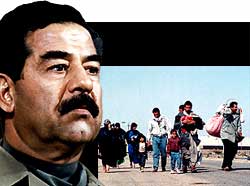
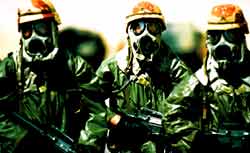
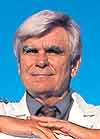 “If you have a contagious disease that is brought back from a war and it’s slowly penetrating into the population, don’t you think that’s alarming?”
“If you have a contagious disease that is brought back from a war and it’s slowly penetrating into the population, don’t you think that’s alarming?”
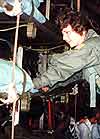 “Given the fact that there are now 400,000 sick, in 10 years’ time, I would say [there will be] 80,000 to 100,000 deaths.”
“Given the fact that there are now 400,000 sick, in 10 years’ time, I would say [there will be] 80,000 to 100,000 deaths.”
 “I found [a Gulf veteran] in a psychiatric ward. No wonder he was upset. He had so many medical problems that weren’t being dealt with. They ignored his blood count and his internal bleeding. It was pathetic.”
“I found [a Gulf veteran] in a psychiatric ward. No wonder he was upset. He had so many medical problems that weren’t being dealt with. They ignored his blood count and his internal bleeding. It was pathetic.”
 “[VA superiors] were so mad at me. But I don’t care. I mean, what I was saying was true....There were lives at stake. And these people really were sick. They were horribly sick. They still are.”
“[VA superiors] were so mad at me. But I don’t care. I mean, what I was saying was true....There were lives at stake. And these people really were sick. They were horribly sick. They still are.”
